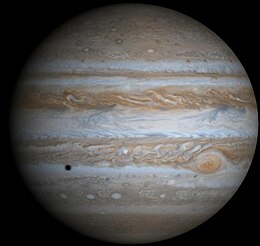Equatorial strip
In astronomy, the equatorial stripes are those elongated cloud structures that occur on large gas planets and run parallel to the equator there . They are a consequence of the rapid rotation of these planets, which divides the atmosphere into different latitudes and is accompanied by strong winds .

The equatorial stripes can be seen most clearly at the gas giant Jupiter , the largest planet in the solar system . They can already be seen in good binoculars (from about ten times magnification), as a system of mostly three parallel dark stripes ("bands"), which are interrupted by bright zones. They represent clouds of different temperatures (around ± 20 ° C), which is partly due to their different heights and ice crystals . The degree of darkness varies greatly, as do the embedded patches of color (mostly methane ), notches and turbulence . Sometimes the three bands merge into one, which then covers almost a third of the planet's entire cloud surface.
Stripes of clouds can also be observed on Saturn , but less clearly. This is due on the one hand to the lower temperatures, on the other hand to a presumed layer of haze that is likely to lie over most of the planet.
At Uranus , the equatorial bands are very weak and almost without winds, while the cloud strips and wind zones in central and arctic regions are much clearer. In contrast to Jupiter and Saturn, however, the axis of rotation is not perpendicular to the orbital movement, but lies almost in the plane of the orbit . These cloud formations could only be examined in more detail in 2003 and 2007 by the 10-m telescope of the Keck Observatory .
The cloud strips on Neptune , on the other hand, have been known since 1989, when the Voyager 2 probe advanced to this outermost planet in the solar system. Neptune had at that time - comparable to the Great Red Spot of Jupiter - in addition to the strip a Great Dark Spot disappeared later ( "Great Dark Spot"), which as well as regional white clouds, which - despite the low temperatures of -220 ° C - the presence violent eddy systems , to which the higher methane content of the atmosphere also contributes.
It can be assumed with some probability that there are equator-parallel bands of different temperatures on exoplanets as well.
literature
- Patrick Moore et al .: Atlas of the Solar System (p.260f, 322f and 388-395), Herder-Verlag, Freiburg-Vienna 1985/86
- Joachim Herrmann: dtv atlas astronomy (sections Outer Planets, Exoplanets). 15th edition, DTV, Munich 2005
Web links
- Uranus in 2003: Zonal Winds, Banded Structure .. (UCRL-Journal April 11, 2005) (PDF file, English; 5.8 MB)